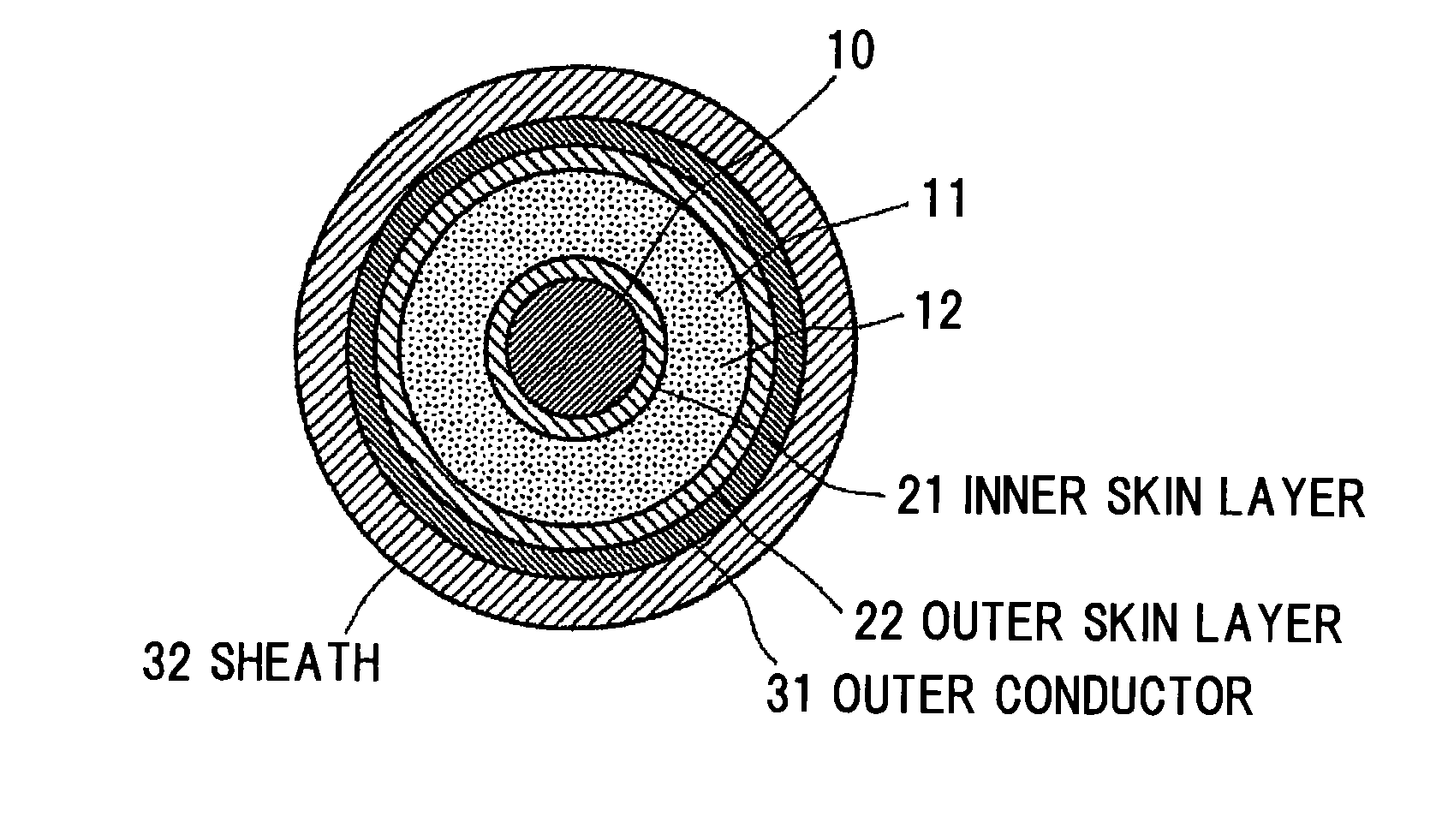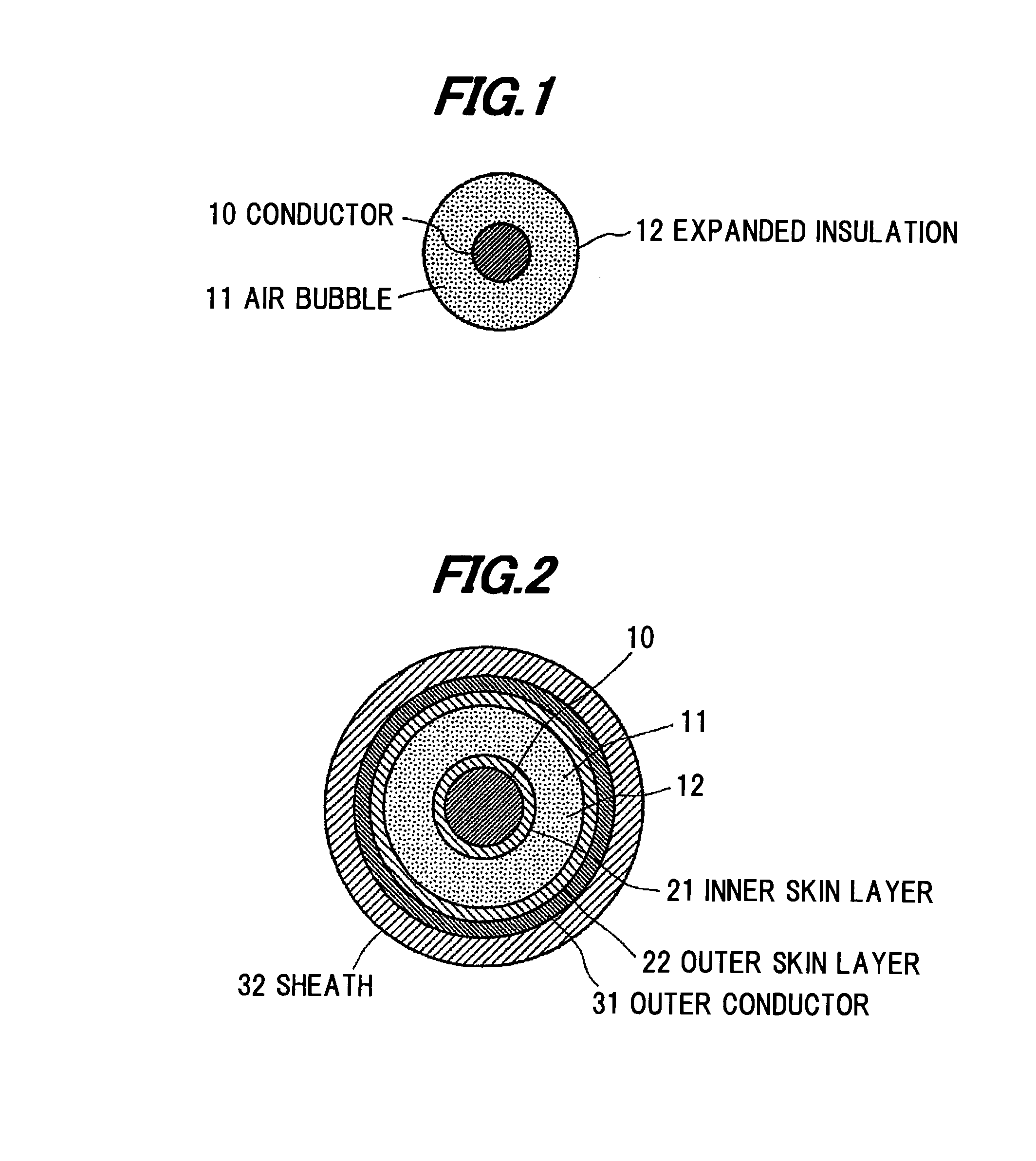Foamed resin composition and wire/cable using the same
a technology of foaming resin and wire, which is applied in the direction of plastic/resin/waxes insulators, organic insulators, electrical appliances, etc., can solve the problems of large permittivity of insulators, difficult to achieve high foaming rates, and delay time differences or skews, etc., to achieve stable foaming rate, lower skew, and high foaming.
- Summary
- Abstract
- Description
- Claims
- Application Information
AI Technical Summary
Benefits of technology
Problems solved by technology
Method used
Image
Examples
example 1
[0068]Example 1 is a result that the norbornene resin was directly introduced into the foam extruder.
[0069]Each pellet was introduced into the foam extruder at a mixing ratio of 0.5 parts by weight of norbornene-based resin (ZEONEX480R, manufactured by Zeon Corporation) to 60 parts by weight of HDPE (6944, manufactured by Nippon Unicar Company Limited) and 39.5 parts by weight of LDPE (B028, manufactured by UBE-MARUZEN POLYETHYLENE Co., Ltd.), thereby experimentally manufacturing a foam insulated wire.
example 2
[0070]Example 2 is an example of initially kneading the norbornene-based resin and LDPE in the twin-screw kneader for making a master batch (MB).
[0071]LDPE (B028, manufactured by UBE-MARUZEN POLYETHYLENE Co., Ltd.) was used as a base resin for making the MB. Pellets were mixed at a ratio of 5 parts by weight of norbornene-based resin (TOPAS6013, manufactured by Polyplastics Co., Ltd.) to 95 parts by weight of the LDPE and were kneaded in the twin-screw kneader.
[0072]The above-mentioned MB was pelletized and was introduced into the foam extruder at a mixing ratio of 60 parts by weight of HDPE (6944, manufactured by Nippon Unicar Company Limited) and 30 parts by weight of LDPE (B028, manufactured by UBE-MARUZEN POLYETHYLENE Co., Ltd.) to 10 parts by weight of the MB, thereby experimentally manufacturing a foam insulated wire.
example 3
[0073]Example 3 is an example in which, although a MB is made by the twin-screw kneader in the same manner as Example 2, the grade of the used norbornene resin is such that the glass transition temperature is high (178° C.) for the comparison.
[0074]LDPE (B028, manufactured by UBE-MARUZEN POLYETHYLENE Co., Ltd.) was used as a base resin for making the MB. Pellets were mixed at a ratio of 8 parts by weight of norbornene-based resin (TOPAS6017, manufactured by Polyplastics Co., Ltd.) to 92 parts by weight of the LDPE and were kneaded in the twin-screw kneader.
[0075]The above-mentioned MB was pelletized and was introduced into the foam extruder at a mixing ratio of 60 parts by weight of HDPE (6944, manufactured by Nippon Unicar Company Limited) and 30 parts by weight of LDPE (B028, manufactured by UBE-MARUZEN POLYETHYLENE Co., Ltd.) to 10 parts by weight of the MB, thereby experimentally manufacturing a foam insulated wire.
[0076]As for Comparative Examples, from a consideration of the p...
PUM
| Property | Measurement | Unit |
|---|---|---|
| mass % | aaaaa | aaaaa |
| mass % | aaaaa | aaaaa |
| melting point | aaaaa | aaaaa |
Abstract
Description
Claims
Application Information
 Login to View More
Login to View More - R&D
- Intellectual Property
- Life Sciences
- Materials
- Tech Scout
- Unparalleled Data Quality
- Higher Quality Content
- 60% Fewer Hallucinations
Browse by: Latest US Patents, China's latest patents, Technical Efficacy Thesaurus, Application Domain, Technology Topic, Popular Technical Reports.
© 2025 PatSnap. All rights reserved.Legal|Privacy policy|Modern Slavery Act Transparency Statement|Sitemap|About US| Contact US: help@patsnap.com


